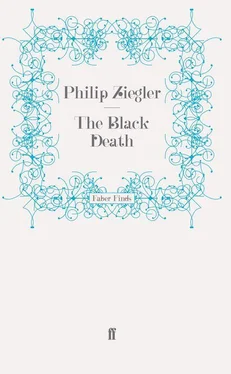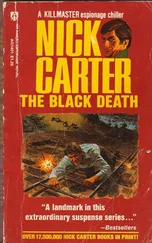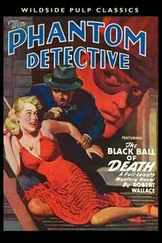It is doubtful if these precautions did anything to reduce the risk of infection with the possible exception of one recipe of Dionysius Colle for a powder, used for throwing on the fire, which contained sulphur, arsenic and antimony. {131} 131 27 D. J. Colle, De Pestilentia, Pisa, 1617, p. 570.
The first of these is now recognized as being destructive to bacteria as well as to rats and fleas. The other compounds, in most cases, had the minor merit of making the usually smelly medieval house a little more agreeable to live in.
Vegetable inactivity was the ideal posture in which to meet the plague. If one had to move, at least move slowly; exercise introduced more air into the body and, with the air, more poison. Hot baths, which opened pores in the skin, were to be shunned for the same reason, though it was beneficial to bathe the face and hands from time to time in vinegar or the inevitable rose-water.
There was general agreement also on the best kinds of preventive medicine. A fig or two with some rue and filberts taken before breakfast was a useful start to the day. Pills of aloes, myrrh and saffron were popular. One authority {132} 132 28 Compendium de Epydimia, op. cit, p. 60.
placed his confidence in ten-year-old treacle blended with some sixty elements, including chopped-up snakes, and mixed with good wine. Rhubarb and spikenard was a compound easier to manufacture and to swallow. Witchcraft joined herbalism in the works of Gentile of Foligno {133} 133 29 cit. Campbell, p. 71. [Not in Sudhoff.]
who recommended powdered emerald; a remedy so potent that, if a toad looked at it, its eyes would crack. Gentile also suggested etching on an amethyst the figure of a man bowing, girded with a serpent whose head he held in his right hand and whose tail in his left. To be fully operative the stone had first to be set in a gold ring.
Bleeding was generally held to be a useful preventive device; Ibn Khātimah, {134} 134 30 Sudhoff XIX, pp. 76–7.
for instance, feeling that it could only be beneficial to lose up to eight pounds. Diet was important. Anything which quickly went bad in hot weather was to be avoided. So was fish from the infected waters of the sea. Meat should be roast rather than boiled. Eggs were authorized if eaten with vinegar {135} 135 31 d’Irsay, Annals of Medical History, IX, 1927, p. 174.
but should never be taken hard-boiled. {136} 136 32 Gentile da Foligno, Sudhoff, V, p. 83.
Anyone trying to follow the advice of every expert would have been sadly perplexed. Ibn Khātimah approved of fresh fruit and vegetables but no one else agreed. Gentile of Foligno recommended lettuce, the Faculty of Medicine at Paris forbade it. Ibn Khātimah had faith in egg plant, another expert deplored its use.
It was bad to sleep by day or directly after meals. Gentile believed that it was best to keep steady the heat of the liver by sleeping first on the right side and then on the left. To sleep on one’s back was disastrous since this would cause a stream of superfluities to descend on the palate and nostrils. From thence these would flow back to the brain and submerge the memory.
Bad drove out bad and a school of thought maintained that to imbibe foul odours was a useful if not infallible protection. According to John Colle: ‘Attendants who take care of latrines and those who serve in hospitals and other malodorous places are nearly all to be considered immune.’ It was not unknown for apprehensive citizens of a plague-struck city to spend hours each day crouched over a latrine absorbing with relish the foetid smells.
A tranquil mind was one of the surer armours against infection. Ideally one should retreat to Boccaccio’s enchanted glade, live beautifully, pass one’s time in dalliance and in practising the art of conversation. But dalliance should not be carried too far: sex, like wrath, heated the members and disturbed the equilibrium. One’s mind should be resolutely closed to the agonies of one’s fellow men; sadness cooled the body, dulled the intelligence and deadened the spirit.
It seems unlikely that the intelligent and enlightened men who worked out these preventive measures had any great faith in their efficacy. Essentially they were a morale-building exercise: the morale of the physician, in that they made him feel at least remotely in control of the situation, and of the patient, in that they offered a slight hope of escape from death. But if the doctors lacked confidence in their capacity to keep the plague at bay, still more did they doubt their ability to cure it once it had struck. They knew too well how few of the sick recovered. But this knowledge of their helplessness did not stop them putting forward a host of remedies.
Bleeding was an even more important part of the cure than it had been of prevention. The blood that emerged from the infected would normally be thick and black; it boded even worse for the victim if a thin green scum rose to the surface. If the patient fainted, instructed Ibn Khātimah somewhat heartlessly, pour cold water over him and continue as before. Most surgeons bled for the sake of bleeding, not worrying much where the incision was made. John of Burgundy {137} 137 33 ed. D. W. Singer, Proc. Roy. Soc. Med. ( Hist. Med. ), Vol. 9, 1916, p. 159.
was more scientific. He believed in the existence of emunctories, from which the poison could be expelled by bleeding. The evil vapours, having entered by the pores of the skin, were carried by the blood either to the heart, the liver or the brain. ‘Thus, when the heart is attacked, we may be sure that the poison will fly to the emunctory of the heart, which is the armpit. But if it finds no outlet there it is driven to seek the liver, which again sends it to its own emunctory in the groin. If thwarted there, the poison will next seek the brain, when it will be driven either under the ears or to the throat.’ Each emunctory had a surface vein which corresponded to it and a skilled surgeon could there intercept the poison on its devil’s progress around the body and draw it off before it did more mischief. A common and disastrous mistake was to make the incision on the wrong side of the body; this not only wasted good blood but meant that healthy limbs were corrupted by the degraded liquid which poured in to make up the loss.
As well as bleeding, it was useful to open and cauterize the plague boils or buboes. Various curious substances were applied to the boils to draw off the poison. Gentile used a plaster made from gum resin, the roots of white lilies and dried human excrement, while Master Albert was in favour of an old cock cut through the back. Ibn Khātimah believed that an operation on the bubo was possible between the fourth and seventh day of the disease when the poison was flowing from the heart to the boils. But even a slight mistake in timing could lead to the escape of the vital principle from the heart and the immediate death of the patient.
Various soothing potions were prescribed, in particular a blend of apple-syrup, lemon, rose-water and peppermint. This must at least have been pleasant to drink. Even this consolation was removed when powdered minerals were added to the mixture. There was some belief in the virtues of emeralds and pearls and the medicinal qualities of gold were taken for granted by most authorities. Take one ounce of best gold – was Gentile’s recipe – add eleven ounces of quicksilver, dissolve by slow heat, let the quicksilver escape, add forty-seven ounces of water of borage, keep airtight for three days over a fire and drink until cure or, more probably, death supervened. At least the high price of gold ensured that not many invalids could afford to be poisoned by such medicines.
Just how little the doctors learned from the Black Death is shown by the Tractate of John of Burgundy or John à la Barbe, published in 1365. {138} 138 34 ibid.
It is true that the author had gained much of his experience and no doubt devised his treatments in 1348 and 1349 but he had lived through a second great epidemic in 1361 and, at the time he wrote, was distilling what should have been a lifetime’s learning. The same sterile analysis of causes appeared, the same catalogue of futile preventive methods and still more futile cures. Given the state of medical learning no great leap forward was possible but if Hippocrates had been alive he would at least have discarded a lot of dead wood of proven uselessness and made some sensible and valuable deductions about the conditions in which the epidemic seemed to thrive and the best means of removing them. Of this there was nothing; only the regurgitation of long discredited dogmas and, from time to time, the addition of some new mineral or vegetable gimmick to give the technique of the writer a flavour of modernity.
Читать дальше












